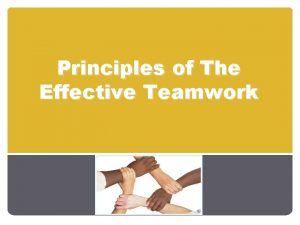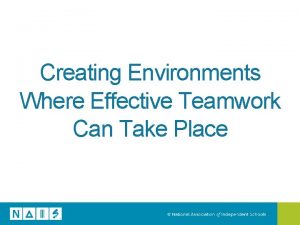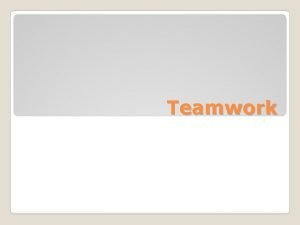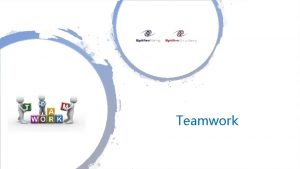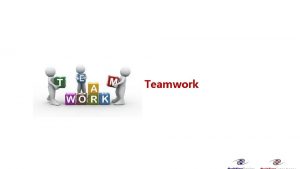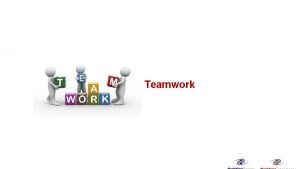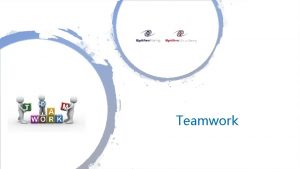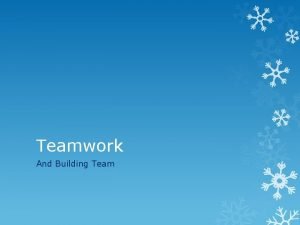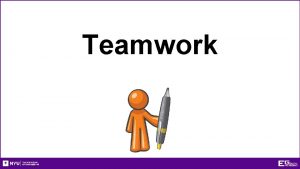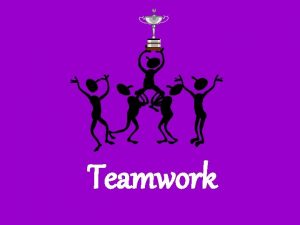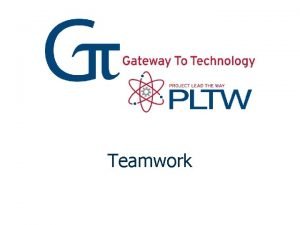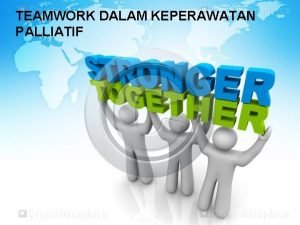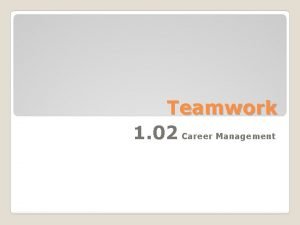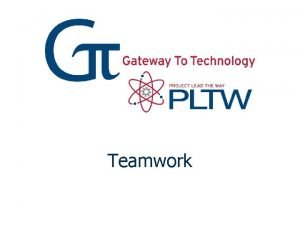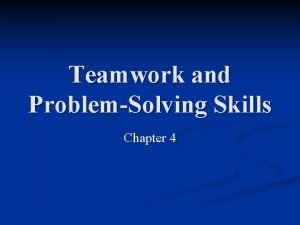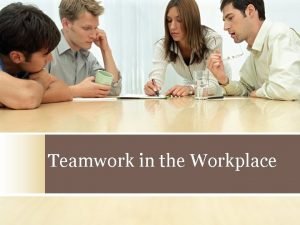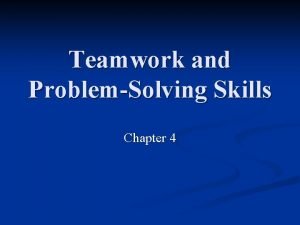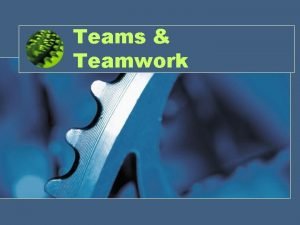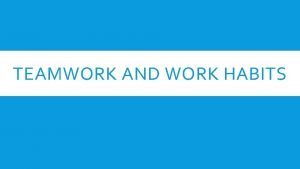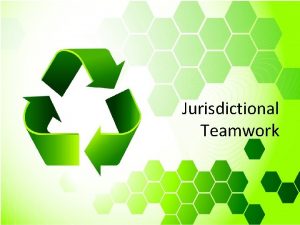Creating Environments Where Effective Teamwork Can Take Place

































- Slides: 33

Creating Environments Where Effective Teamwork Can Take Place

Beyond individual skill development, how do we improve the culture of teamwork and the systems in place at our schools? 2

The Importance of Teamwork

Teamwork: A skill of the future World Economic Forum’s Top 10 Skills Needed to Thrive in 2020 Jomel Alos, “Skills of the Future: 10 Skills You’ll Need to Thrive in 2020, ” Guthrie -Jensen Consultants (February 15, 2018) 4

The link between teamwork/collaboration and performance 64% 5 x “Participants in [a 2014 Stanford study] who were primed to act collaboratively stuck at their task 64% longer than their solitary peers, whilst also reporting higher engagement levels, lower fatigue levels and a higher success rate. What’s more, this impact persisted for several weeks. ” “A recent joint study between the Institute for Corporate Productivity [and Babson College] … found that companies that promoted collaborative working were 5 times as likely to be high performing. ” Adi Gaskell, “New Study Finds That Collaboration Drives Workplace Performance, ” Forbes (June 22, 2017) 5

Benefits of collaboration • “Organizations collaborate internally to compete externally. • Decisions are faster, of higher quality, and customer-driven. • Decisions are made on the basis of principle rather than power or personality, resulting in greater buy-in and impact. • Cycle time is substantially reduced and non-value-adding work eliminated. • The productive capacity of the workforce doubles. • Strategic alliances succeed, while building trust and producing extraordinary results. • Return on investment increases dramatically. • Span of control increases substantially. • The workforce takes on full responsibility for the success of the enterprise. • Conflict is reduced as work relationships open up and build trust. • The fear is gone—change is seen as a positive opportunity. ” Center for Creative Leadership, “How to Lead a Collaborative Team, ” adapted from Edward M. Marshall, Transforming the Way We Work: The Power of the Collaborative Workplace (1995) 6

Teamwork in school boards “Now more than ever, for an independent school to develop and maintain a competitive advantage, it needs a strong team of trustees… “I do not know many boards that spend time reviewing [their] foundational responsibilities annually with all trustees, and fewer still that invest the time to explicitly build a sense of trust and teamwork within their board by asking a few fundamental questions: • How will they function as a group of trustees on behalf of the school they serve? • What do trustees have a right to expect from each other? • What do the communities they serve have a right to expect from them? ” Dick Ewing, “Teamwork: Building the Trust in Trusteeship, ” Independent Ideas blog (February 11, 2015) 7

Teamwork in teaching and learning “Well-functioning leadership and teaching teams are essential to the continuous improvement of teaching and learning. “Effective teams: • strengthen leadership, • improve teaching and learning, • nurture relationships, • increase job satisfaction, and • provide a means for mentoring and supporting new teachers and administrators. ” Dennis Sparks, “Strong Teams, Strong Schools: Teacher-to-Teacher Collaboration Creates Synergy That Benefits Students, ” JSD: The Learning Forward Journal (April 2013) 8

Teamwork in sustaining teachers “Teachers have very challenging and stressful jobs, and part of what contributes to their level of challenge and stress is a teacher’s tendency to isolate him- or herself. ” This is often because of physical isolation and in response to feeling overwhelmed. “The surest way to reduce workplace stress is to help your people build meaningful connections and feel like a valuable part of something larger than themselves. Building that kind of culture requires administrations setting aside time and emphasizing the importance of teacher teamwork instead of simply suggesting that it occur on its own. ” Sean Glaze, “For Effective Schools, Teamwork Is Not Optional, ” Edutopia (May 20, 2014) 9

Key characteristics of effective school teams MEMBERS OF A TRUSTING TEAM A TEAM WITH EFFECTIVE TEAM STRUCTURES Have discussions, with the encouragement of different viewpoints, about how to reach goals. Has observable processes in action when the team is working and meeting. Have the courage to share their viewpoint, even if it varies Has defined roles and responsibilities for members; from the majority of the group. however, the roles and responsibilities can and should be shared. Are open-minded, listen, and give colleagues a chance to Uses protocols to help guide group work and provide speak. Respectful dialogue is the norm. a consistent framework. Are able to engage in “unfiltered conflict” around ideas. Has agreements in place that are clear, purposeful, Admit weaknesses and mistakes and ask for help. Accept and understood. These agreements drive meetings, questions and input about their areas of responsibility. the intent being to maximize time and efficiency. Give one another the benefit of the doubt before arriving Has an identified facilitator, as well as secondary at a negative conclusion. facilitators, who keep the team focused on the goals. Take risks in offering feedback and assistance. Meetings have a start and end time, as well as an agenda. Appreciate/tap into one another’s skills and experiences. Has an understanding of how decisions will be made. Offer and accept apologies without hesitation. Engages regularly in reflection on the content and process of team meetings and celebrates progress. Look forward to meetings and opportunities to work as a group. Dennis Sparks, “Strong Teams, Strong Schools: Teacher-to-Teacher Collaboration Creates Synergy That Benefits Students, ” JSD: The Learning Forward Journal (April 2013) 10

Key characteristics of effective school teams (cont. ) IN A TEAM WITH CLARITY OF PURPOSE A TEAM FOCUSED ON ACCOUNTABILITY There are clearly defined, transparent goals aligned with the mission and vision of the district. Is committed to decisions and plans of action. All team members are committed to these goals and to Holds one another accountable for delivering against the a clearly articulated plan of action. plans agreed to and feels a sense of obligation to the team for its progress. Goals are specific, measurable, attainable, realistic, Focuses on the achievement of collective results for and timely (SMART). student learning. There is shared clarity about how the work of the team Reviews, studies, interprets, and acts on data. will affect student achievement. Willingly reviews its progress, can describe its work to others, and welcomes feedback and suggestions. Identifies potential problems quickly by questioning one another’s approaches without hesitation. Engages in formal monitoring of progress on SMART goals. Dennis Sparks, “Strong Teams, Strong Schools: Teacher-to-Teacher Collaboration Creates Synergy That Benefits Students, ” JSD: The Learning Forward Journal (April 2013) 11

Factors that separate great teams from good ones 1. Great teams are committed to the vision and to achieving extraordinary results. “On great teams, individual goals are set aside for the benefit of the team. ” 2. They share accountability for the results. “When teams have an unbelievably high bar they’re trying to reach as a team, the barriers between individuals seem to fall, and they act more as business owners, as opposed to functional leaders. ” 3. Their communication is transparent. “Do we communicate frequently and informally…? Do we have access to the information we need to do our jobs more effectively? ” 4. They resolve conflict constructively and have clarity on decisionmaking roles. 5. They have mutual respect for each other and strong camaraderie. “Central to having a strong team is building a climate of trust. ” Lindsay Lavine, “ 5 Factors That Separate Great Teams From Good Ones, ” Fast Company (July 22, 2014) 12

Traits of successful teams “It all comes down to a combination of the right people and the right actions—and a commitment to improving your team for the better. ” • Dependability: “Trusting that your co-workers can—and will—get things done is the first step to effective collaboration. ” • Driven by purpose: “Remind your team what your objectives and drive are—and how each individual brings a unique set of skills to the mission at hand. ” • Culture fit: “A candidate who has tons of knowledge and experience but lacks the passion, quirkiness, or personality to work well with the existing team will struggle to achieve and innovate. ” • Constructive conflict: “While building healthy habits to manage differing opinions on the team may be hard at first, it’s crucial. ” • Appreciation: “Research shows how powerful the impact of peer-topeer appreciation can be on an individual’s performance. ” David Sturt and Todd Nordstrom, “ 5 Irreplaceable Traits of Successful Teams—Where Do You Fit? ” Forbes (June 30, 2016) 13

Workplace Culture and School Systems

Leading a collaborative team “Building a collaborative team requires the leader to address what isn’t working, view trust as a must-have resource and insist on behaviors that support collaborative principles. “Understand why teams often don’t work. . . • • • the history of the team, poor relationships, ineffective meetings, little transparency or inadequate sharing of information, no team governance processes, conflicting styles of decision-making, behind-the-scenes conversations and processes, competition, turf wars, poor ownership or engagement among team members. ” Center for Creative Leadership, “How to Lead a Collaborative Team, ” adapted from Edward M. Marshall, Transforming the Way We Work: The Power of the Collaborative Workplace (1995) 15

Leading a collaborative team (cont. ) Commit to building trust “[Former CCL partner Edward M. Marshall explains, ] ‘With no fear, … teams gain productive energy, creativity, speed and better results. ’ [However, ] trust can’t be trained into a team. It takes a leader who is willing to show integrity, change behavior and take on the hard work of dealing with differences. ” Operate on principle “Lead a team based on principles rather than structures, politics or personality. Marshall’s ‘Principles of Collaboration’ are ownership, alignment, full responsibility, self-accountability, mutual respect, integrity, and trust. … Your job as team leader is to help the team turn these values into agreed-upon behaviors or operating agreements. ” Center for Creative Leadership, “How to Lead a Collaborative Team, ” adapted from Edward M. Marshall, Transforming the Way We Work: The Power of the Collaborative Workplace (1995) 16

Nourishing a schoolwide team culture • “Begin moving from a strong individual leader to shared leadership…. moving away from the model of one leader through which all strategy flows to a model of collective responsibility. • “Differentiate the team’s purpose from the larger organizational mission…. A team that focuses on one BHAG (big, hairy, audacious goal), such as the financial sustainability of the school or an opportunity to reinvent itself for a changing market, can be more effective in addressing complex issues. • “Restructure to focus on a collective outcome rather than individual outputs…. A group of diverse individuals can be more effective in finding a solution to a challenging issue or a new way to approach an emerging opportunity than individuals working solo on related initiatives. ” Donna Orem, “Harnessing the Power of Teams to Tackle Complex Challenges, ” Independent Ideas blog (August 14, 2017) 17

Nourishing a schoolwide team culture (cont. ) • “Run generative vs. solution-based meetings. … having less bias for action and solutions and more practice of asking probing questions and making sense of circumstances. • “Discuss, wrestle with, and produce outcomes together rather than delegate. …The time spent together usually produces much more high-quality results. • “Measure performance by outcomes rather than outputs…. For example, if school leaders are trying to improve staff recruitment, they could set a goal of raising salaries to the top 20 percent of the market, hoping that will increase the pool of high-quality candidates. However, if they set an outcome goal instead, they would redesign the total approach to recruitment [and] the desired outcome would be that the school becomes the employer of choice in that market. ” Donna Orem, “Harnessing the Power of Teams to Tackle Complex Challenges, ” Independent Ideas blog (August 14, 2017) 18

Understanding the benefits of a “giver” culture “Helping-behavior facilitates organizational effectiveness by • enabling employees to solve problems and get work done faster. • enhancing team cohesion and coordination. • ensuring that expertise is transferred from experienced to new employees. • reducing variability in performance when some members are overloaded or distracted. • establishing an environment in which customers and suppliers feel that their needs are the organization’s top priority. ” “Giver cultures: Employees help one another, share knowledge, offer mentoring, make connections without expecting anything in return. “Taker cultures: Employees get as much as possible from others while contributing less in return. “Matcher cultures: Employees help only those who help them, maintaining an equal balance of give and take. ” Donna Orem, “Why Hiring ‘Givers’ Matters, ” Independent School magazine (Fall 2017) 19

Identifying “takers” in the hiring process “Takers take personal credit for Three Hiring Mistakes to Avoid their successes. They will use the 1. Hiring to meet a multitude of needs: words ‘I’ and ‘me’ exclusively in Because of scarce resources, we often responding to interview questions. try to have one position fill many needs. “Takers often manage up and kick 2. Using aspirational thinking in hiring: There’s a difference between wanting down. They are charming to to nurture talent and blindly putting supervisors but often abusive with someone into a position based on gut subordinates. feeling and hope. “Takers engage in antagonistic 3. Hiring from a weak pool: Because of timing and resources, we may choose behavior at the expense of others. an employee from the best of a They often put others down or will talk mediocre pool or not cast the net widely about their success in relation to how enough to bring in people with varying much better they are than others. ” backgrounds. Donna Orem, “Why Hiring ‘Givers’ Matters, ” Independent School magazine (Fall 2017), summarizing Adam Grant, Give and Take: Why Helping Others Drives Our Success (2014) Curtis Chang, “Three Nonprofit Hiring Mistakes to Avoid, ” Stanford Social Innovation Review (September 29, 2011) 20

Culture change: What is, what should be, what will be “What Is”/Understanding Your Current Culture: “Instead of trying immediately to define your ideal culture, take some time to understand exactly what is valued in your current culture…. If you start moving in a new direction without clarifying and acknowledging your starting point, you’re bound to get more resistance. ” “What Should Be”/Making the Case for Culture Change: “You have to be able to show people how [your] culture either supports or gets in the way of what makes your school—and all the individuals inside it—more successful…. What makes you stand out from the schools you compete with? What are you already admired for internally and externally? ” “What Will Be”/Taking Action: “Instead of having the daunting task of completely transforming your culture, you can actually mobilize people around a handful of key priorities, and that makes the action planning more manageable. ” Jamie Notter, “Leadership Lessons: What It Takes to Build Workplace Culture, ” Independent School magazine (Fall 2018) 21

Building a psychologically safe workplace “Psychological safety is a belief that one will not be punished or humiliated for speaking up with ideas, questions, concerns or mistakes. “If you have uncertainty and interdependence it’s absolutely vital you have psychological safety. ” Amy Edmondson, “Building a Psychologically Safe Workplace, ” TEDx. HGSE, Harvard Graduate School of Education (May 4, 2014) 22

Building a psychologically safe workplace (cont. ) Separate research studies by Google and Amy Edmondson of Harvard Business School came to the same conclusion: “The teams which made more mistakes were actually more successful. Creating an environment in which people feel comfortable to take risks is key to fostering innovative workplaces. ‟Steps to foster psychological safety in your workplace: ‟ 1. Lead by example • Ask for upward feedback • Acknowledge your mistakes • Make an effort to take on … opinions that differ from your own • Be approachable and encourage reports to ask questions” Impraise Blog, “What Is Psychological Safety and Why Is It the Key to Great Teamwork? ” 23

Building a psychologically safe workplace (cont. ) “ 2. Encourage active listening • Leave phones at the door during meetings • Show understanding by repeating what was said • Encourage people to share more by responding and asking questions • If certain individuals rarely speak … actively ask them for their opinion ‟ 3. Create a safe environment • Don’t allow people to interrupt each other • All ideas should be accepted equally and never judged • Never place blame • Encourage out of the box and off the wall suggestions… ‟ 4. Develop an open mindset • Help your team become comfortable receiving feedback from each other • Teach them how to first listen, analyze and then respond to input from others • Encourage your team to see feedback as a way to strengthen their ideas. ” Impraise Blog, “What Is Psychological Safety and Why Is It the Key to Great Teamwork? ” 24

“Systems thinking”: Common archetypes By understanding underlying structures that produce behaviors across a system, teams can shift perspectives and identify levers for change. Common systems archetypes, positive and negative: • “Fixes that fail”: We can see this archetype playing out when a school faces a budget crisis. A major donor steps in to solve the financial crisis, but the fix is short-lived. By the time the financial crisis returns, school leaders have lost the time and resources needed to pinpoint the real issue and make changes to return the system to financial health. • “Limits to growth”: Growth of any kind usually does not go on forever, but organizations tend to ride growth too long. • “Tragedy of the commons”: A shared resource will inevitably get exploited by someone wanting individual gain. When many seek to maximize benefit, intense competition and exploitation arise to the detriment of all. Donna Orem, “Identifying System Archetypes to Build High-performing Teams, ” Independent Ideas blog (March 18, 2019) 25

“Systems thinking”: Common archetypes (cont. ) • “Escalation”: When people begin “one-upping” each other, fighting for limited resources • “Eroding goals”: When goals aren’t met, the desired outcomes often shift downward, eroding quality. • “Addiction”: We can become addicted to an eternal force to maintain the system. • “Exponential success”: Success can drive a “winning at all cost” mindset, thus eroding teamwork. • “Race to the bottom”: Competing by low cost alone can drive quality to erode as an industry competes on volume alone. • “Shifting the burden”: A decision made to fix something in one part of a system inadvertently shifts the burden to another part of the system. Donna Orem, “Identifying System Archetypes to Build High-performing Teams, ” Independent Ideas blog (March 18, 2019) 26

Breaking out of decision-making patterns When a problem arises: • Define the problem symptom—for example, a symptom for a school in a budget crisis may be declining demand. • Examine past “solutions” to the problem as well as current and planned ones to map out the various mental models for pursuit. • Map unintended consequences. • Identify the dynamics that created the problem symptoms—in this case, what has led to a lessening of demand for the school. • Look for connections between the unintended consequences and the fundamental causes of the problem symptom. • Identify high-leverage interventions—changes that a team can make to the underlying structure that can begin to alleviate the problem. • Map the potential side effects of any proposed intervention. • Cultivate joint understanding of the archetype. Donna Orem, “Identifying System Archetypes to Build High-performing Teams, ” Independent Ideas blog (March 18, 2019) 27

Considering personalities and roles on teams “Observing the balance of roles in a team offers an extraordinary insight into its dynamics. ” “A useful way to think about teams with the right mix of skills and personalities is to consider the two roles every person plays in a working group: a functional role, based on their formal position and technical skill, and a psychological role, based on the kind of person they are. Too often, organizations focus merely on the functional role and hope that good team performance somehow follows. ” Dave Winsborough and Tomas Chamorro-Premuzic, “Great Teams Are About Personalities, Not Just Skills, ” Harvard Business Review (January 25, 2017) 28

Considering personalities and roles on teams (cont. ) ‟Results-oriented. Team members who naturally organize work and take charge tend to be socially self-confident, competitive, and energetic. ‟Relationship-focused. Team members who naturally focus on relationships, are attuned to others’ feelings, and are good at building cohesion tend to be warm, diplomatic, and approachable. ‟Process and rule followers. Team members who pay attention to details, processes, and rules tend to be reliable, organized, and conscientious. ‟Innovative and disruptive thinkers. Team members who naturally focus on innovation, anticipate problems, and recognize when the team needs to change tend to be imaginative, curious, and open to new experiences. ‟Pragmatic. Team members who are practical, hard-headed challengers of ideas/theories tend to be prudent, emotionally stable, level-headed. ” Dave Winsborough and Tomas Chamorro-Premuzic, “Great Teams Are About Personalities, Not Just Skills, ” Harvard Business Review (January 25, 2017) 29

Improving communication on teams MIT’s Human Dynamics Laboratory found patterns of communication to be the most important predictor of a team’s success. “Successful teams share several defining characteristics: 1. Everyone on the team talks and listens in roughly equal measure, keeping contributions short and sweet. 2. Members face one another, and their conversations and gestures are energetic. 3. Members connect directly with one another—not just with the team leader. 4. Members carry on back-channel or side conversations within the team. 5. Members periodically break, go exploring outside the team, and bring information back. ” Alex “Sandy” Pentland, “The New Science of Building Great Teams, ” Harvard Business Review (April 2012) 30

Setting norms for team behavior “Your job as team leader is to help the team turn [Edward Marshall’s Principles of Collaboration] into agreed-upon behaviors or operating agreements. “‘Operating agreements are the conscious choices we agree to 100% as a team, which define how we will work with each other. They are the foundation for mutual trust, respect and high performance, ’ says [Edward Marshall]. ” Center for Creative Leadership, “How to Lead a Collaborative Team, ” adapted from Edward M. Marshall, Transforming the Way We Work: The Power of the Collaborative Workplace (1995) 31

NAIS School Leadership Team Experience A three-day learning experience for school leadership teams. Groups focus on collaboration and building leadership capacity to support school improvement. They consult with educational leadership experts as they work through real and specific challenges and opportunities facing their school. School teams that will benefit from SLTE include: • Teams who want to streamline communication and learn processes associated with problem identification, root cause analysis, and researchbased solution design; • Teams with multiple new hires or new leadership; and • Teams who are facing complex and challenging school issues such as enrollment management, affordability, demographic changes, need for differentiation in the marketplace, etc. NAIS School Leadership Team Experience, July 28–August 1, 2019, www. nais. org/participate/institutes-workshops/school-leadership-team-experience/ 32

Resources • Jomel Alos, “Skills of the Future: 10 Skills You’ll Need to Thrive in 2020, ” Guthrie-Jensen Consultants • Adi Gaskell, “New Study Finds That Collaboration Drives Workplace Performance, ” Forbes • Center for Creative Leadership, “How to Lead a Collaborative Team” • Dick Ewing, “Teamwork: Building the Trust in Trusteeship, ” Independent Ideas blog • Dennis Sparks, “Strong Teams, Strong Schools, JSD: The Learning Forward Journal • Sean Glaze, “For Effective Schools, Teamwork Is Not Optional, ” Edutopia • Lindsay Lavine, “ 5 Factors That Separate Great Teams From Good Ones, ” Fast Company • David Sturt and Todd Nordstrom, “ 5 Irreplaceable Traits of Successful Teams, Forbes • Donna Orem, “Harnessing the Power of Teams to Tackle Complex Challenges, ” Independent Ideas blog • Donna Orem, “Why Hiring ‘Givers’ Matters, ” Independent School magazine • Curtis Chang, “Three Nonprofit Hiring Mistakes to Avoid, ” Stanford Social Innovation Review • Jamie Notter, “Leadership Lessons: What It Takes to Build Workplace Culture, ” Independent School magazine • Amy Edmondson, “Building a Psychologically Safe Workplace, ” TEDx. HGSE, Harvard Graduate School of Education • Impraise Blog, “What Is Psychological Safety and Why Is It the Key to Great Teamwork? " • Donna Orem, “Identifying System Archetypes to Build High-performing Teams, ” Independent Ideas Blog (March 18, 2019) • Dave Winsborough and Tomas Chamorro-Premuzic, “Great Teams Are About Personalities, Not Just Skills, ” Harvard Business Review • Alex “Sandy” Pentland, “The New Science of Building Great Teams, ” Harvard Business Review • NAIS School Leadership Team Experience, www. nais. org 33
 Creating supportive environments smoking
Creating supportive environments smoking Summary of poem teamwork
Summary of poem teamwork Aodhan king alexander pappas
Aodhan king alexander pappas Team work principles
Team work principles Effective teamwork
Effective teamwork Take a bus or take a train
Take a bus or take a train Where does photosynthesis take place
Where does photosynthesis take place Energy transformations lab
Energy transformations lab Where did the renaissance take place
Where did the renaissance take place Important events of the renaissance
Important events of the renaissance The landlady characters
The landlady characters Where did the french and indian war take place
Where did the french and indian war take place Ratatouille take place
Ratatouille take place Pronouns take the place of
Pronouns take the place of Pop vs folk culture
Pop vs folk culture Where does photosynthesis occur?
Where does photosynthesis occur? Where does the calvin cycle take place
Where does the calvin cycle take place Who is macduff in macbeth
Who is macduff in macbeth Where does the krebs cycle take place
Where does the krebs cycle take place Cellular respiration exit ticket
Cellular respiration exit ticket Krebs cycle occurs in
Krebs cycle occurs in Where does cellular respiration take place
Where does cellular respiration take place Where does glycolysis take place
Where does glycolysis take place How does photosynthesis take place?
How does photosynthesis take place? Where does the electron transport chain take place
Where does the electron transport chain take place Who is the protagonist in beowulf
Who is the protagonist in beowulf Caesura example in beowulf
Caesura example in beowulf Photosynthesis and cellular respiration diagram
Photosynthesis and cellular respiration diagram Cask of amontillado setting
Cask of amontillado setting Questions and answers of marriage is a private affair
Questions and answers of marriage is a private affair Most reactions take place in a number of
Most reactions take place in a number of Plot chart for “eleven”
Plot chart for “eleven” Where did the townshend act take place
Where did the townshend act take place Pronouns for a place
Pronouns for a place



